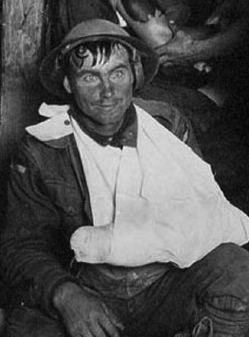World War I was one of the most devastating and brutal wars in human history. During this war, over 250,000 soldiers suffered the pain and agony caused by “shell shock,” a condition that was first introduced by British medical officer Charles Myers in 1915. In this article, we will explore how shell shock affected soldiers during World War I and how science stepped in to help us understand these psychological disorders.
Why Shell Shock?
At the beginning of the 20th century, World War I had reached a stage where military tactics had drastically changed. The extensive use of heavy artillery bombardments, rocket attacks, and trench warfare created incredibly harsh and intense conditions for soldiers. In such conditions, many soldiers began to show strange symptoms of psychological and neurological disorders, which were initially thought to be physical injuries caused by artillery shells and explosions.
Charles Myers, a British army doctor, was the first to use the term “shell shock” to describe these phenomena. Initially, he believed that the disorder was caused by physical damage to the nervous system due to explosions and bombardments. However, over time, it became clear that the disorder might stem more from psychological and emotional stress caused by the war, rather than purely physical injuries.
Psychological and Physical Damage: A New Diagnosis in World War I
At the beginning of World War I, doctors and military specialists mistakenly believed that shell shock was only caused by physical injuries to the nervous system. These assumptions were limited to those who were directly exposed to artillery shelling and explosions. However, as new findings emerged, it became clear that even soldiers who had never been directly exposed to bombardments exhibited similar symptoms of psychological disorders.
Soldiers and officers who were in the war zones were severely affected by the intense stress and trauma of war. What initially seemed strange and inexplicable to doctors was that some soldiers who had never been directly exposed to blasts or gunfire still displayed the same symptoms of psychological and neurological damage.
Shell Shock and PTSD: The Medical and Scientific Connection
Today, the condition that was referred to as “shell shock” during World War I is known as Post-Traumatic Stress Disorder (PTSD). PTSD refers to a set of psychological symptoms that arise after experiencing a traumatic or shocking event. These symptoms can include nightmares, severe anxiety, depression, and a feeling of disconnection from the world around them.
In fact, shell shock was not just the result of physical injuries but was primarily caused by psychological and emotional trauma associated with the war. Soldiers who were exposed to these conditions were indirectly suffering from the extreme stress and anxiety of war, which could persist long after their return home.
Psychological Damage of War: The Invisible Wounds
Shell shock serves as a reminder of the invisible wounds experienced by those who witnessed and endured the horrific brutalities of war. This condition was not only about physical injuries but also deeply affected the soul and mind of individuals. The psychological impact of war is far more significant than physical injuries, as these injuries are immediately visible, whereas psychological wounds are often invisible and delayed in their onset.
The fact that shell shock and PTSD were observed in soldiers long after the end of World War I is perhaps the most important reason why psychology and medicine began to understand that wars could have a far deeper and more severe impact on the human psyche. Modern medical studies show that post-traumatic stress can arise from tragic events and severe trauma, and thus, shell shock during World War I indirectly laid the groundwork for extensive research in this area.
The Role of the UNESCO Club in Advancing Scientific Awareness
At the UNESCO Sciences and Technology Club, scientific research on the psychological effects of wars and other human crises continues to be pursued. The club, with its mission to enhance public awareness of mental health issues arising from stress-inducing events and social trauma, engages in educational and research activities.
Today, with advancements in science and medicine, we have a better understanding of conditions such as PTSD and other psychological disorders caused by war. The UNESCO Sciences and Technology Club, as a reputable scientific organization, strives to promote public awareness of psychological issues, mental health, and new treatment approaches. Through these efforts, the club seeks to reduce the damage caused by stressful conditions and expand preventive and therapeutic solutions for psychological trauma.
Conclusion: The Impact of World War I on Psychological and Medical Science
World War I not only caused physical pain and suffering but also deeply affected the souls and minds of humans. Shell shock emerged as a new phenomenon in medical and psychological science, initially thought to be caused by physical injuries, but over time, it was recognized as a psychological disorder primarily caused by the emotional and psychological toll of war. Today, this phenomenon is known as PTSD and is widely discussed and researched in the fields of psychology and medicine.
Ultimately, thanks to scientific and medical advancements, we can now better understand and address the psychological impacts of war and other crises. The UNESCO Sciences and Technology Club, by contributing to this understanding, plays a pivotal role in raising scientific awareness and reducing the pain and suffering caused by stressful and traumatic conditions.
+ Edited by Chat GPT

